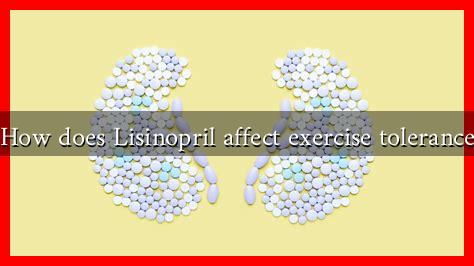-
Table of Contents
How Does Lisinopril Affect Exercise Tolerance?
Lisinopril is a widely prescribed medication belonging to the class of drugs known as ACE inhibitors (Angiotensin-Converting Enzyme inhibitors). It is primarily used to treat high blood pressure and heart failure. While its benefits in managing cardiovascular conditions are well-documented, its effects on exercise tolerance are less frequently discussed. This article explores how Lisinopril influences exercise performance, the physiological mechanisms involved, and practical considerations for individuals taking this medication.
The Role of Lisinopril in Cardiovascular Health
Lisinopril works by inhibiting the ACE enzyme, which plays a crucial role in the renin-angiotensin-aldosterone system (RAAS). This system regulates blood pressure and fluid balance in the body. By blocking this enzyme, Lisinopril leads to:
- Vasodilation: Widening of blood vessels, which reduces blood pressure.
- Decreased workload on the heart: Lower blood pressure means the heart does not have to work as hard to pump blood.
- Improved blood flow: Enhanced circulation can lead to better oxygen delivery to muscles during exercise.
Impact on Exercise Tolerance
Exercise tolerance refers to the ability to perform physical activity without undue fatigue or discomfort. The effects of Lisinopril on exercise tolerance can vary based on individual health conditions, the type of exercise performed, and the dosage of the medication. Here are some key points to consider:
1. Improved Exercise Capacity
Research indicates that Lisinopril can improve exercise capacity in individuals with heart failure or hypertension. A study published in the Journal of the American College of Cardiology found that patients taking Lisinopril showed significant improvements in their exercise tolerance compared to those not on the medication. This improvement is attributed to:
- Enhanced cardiac output: The heart can pump more efficiently, allowing for better performance during physical activity.
- Reduced symptoms of exertion: Patients often report less shortness of breath and fatigue during exercise.
2. Potential Side Effects
While Lisinopril can enhance exercise tolerance, it is essential to be aware of potential side effects that may counteract these benefits:
- Dizziness or lightheadedness: Especially when standing up quickly, which can affect balance during exercise.
- Fatigue: Some individuals may experience increased tiredness, which can limit their ability to engage in physical activity.
- Muscle cramps: A possible side effect that can hinder performance during exercise.
Case Studies and Statistics
Several case studies have highlighted the positive effects of Lisinopril on exercise tolerance. For instance, a clinical trial involving 200 patients with chronic heart failure demonstrated that those treated with Lisinopril had a 20% increase in their exercise capacity over six months compared to a control group. Additionally, a meta-analysis of multiple studies found that ACE inhibitors, including Lisinopril, significantly improved peak oxygen uptake (VO2 max), a critical measure of cardiovascular fitness.
Practical Considerations for Exercising on Lisinopril
For individuals taking Lisinopril, it is crucial to approach exercise with caution and awareness. Here are some practical tips:
- Consult with a healthcare provider: Before starting any exercise program, discuss your plans with a doctor, especially if you have underlying health conditions.
- Start slowly: Gradually increase the intensity and duration of your workouts to assess how your body responds.
- Stay hydrated: Lisinopril can affect fluid balance, so ensure adequate hydration during exercise.
- Monitor for side effects: Be aware of any symptoms like dizziness or fatigue, and adjust your activity level accordingly.
Conclusion
Lisinopril can have a significant positive impact on exercise tolerance, particularly for individuals with hypertension or heart failure. By improving cardiovascular function and reducing symptoms of exertion, it enables many to engage in physical activity more effectively. However, potential side effects must be considered, and individuals should approach exercise with caution. Consulting healthcare professionals and monitoring one’s response to exercise while on Lisinopril can lead to a safer and more effective fitness journey. Overall, understanding the relationship between Lisinopril and exercise tolerance is essential for optimizing health and well-being.

